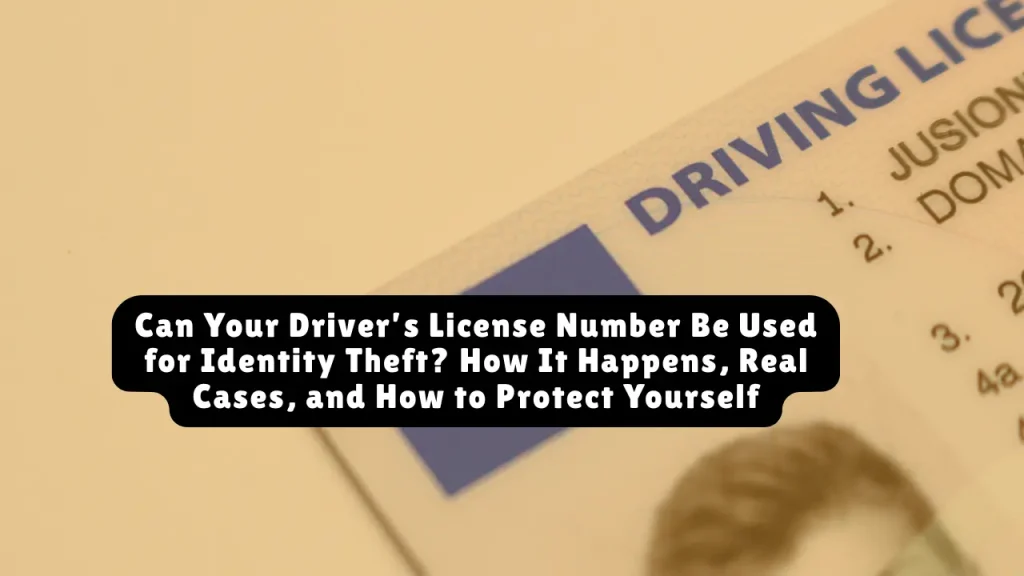Can Your Driver’s License Number Be Used for Identity Theft? How It Happens, Real Cases, and How to Protect Yourself
Yes — your driver’s license number can be used for identity theft. Criminals use it to forge IDs, open financial accounts, reroute your mail, apply for benefits, create synthetic identities, and more. The consequences range from financial loss to false criminal records. Immediate action and robust digital and physical protections are key.
Table of Contents
Why Driver’s License Numbers Are a Prime Target
A driver’s license number is more than just a random string of digits—it’s a core piece of personally identifiable information (PII). When combined with your name, address, and date of birth, it becomes a goldmine for cybercriminals. From fake IDs to fraudulent loans, the ways thieves exploit this number are increasingly sophisticated.
How Criminals Steal Driver’s License Numbers
- Data Breaches: DMV systems or third-party vendors are frequent targets of cyberattacks. One 2024 vendor hack leaked over 5 million DL records in Florida alone.
- Phishing & Social Engineering: Scammers impersonate banks or government officials via emails or phone calls to trick victims into revealing license images or numbers.
- API Exploits & Mobile Apps: Criminals exploit vulnerabilities in third-party apps that handle identity verification.
- Dark Web Purchases: Stolen driver’s license numbers sell for as little as $70, often bundled with other PII like Social Security numbers.
Read also: Can You Get a New Social Security Number After Identity Theft in 2025?

What Thieves Do With Your Driver’s License Number
1. Create Fake IDs
Using your license number and their photo, thieves forge IDs to:
- Evade law enforcement during traffic stops.
- Commit crimes or collect traffic violations in your name—potentially leading to wrongful warrants or court summons.
2. Build Synthetic Identities
Thieves combine your license number with fake or stolen Social Security numbers to:
- Open bank accounts and apply for credit cards.
- Claim unemployment benefits or loans.
- Bypass background checks for jobs.
3. Commit Mail & Tax Fraud
Criminals may reroute your mail by filing a false change-of-address using license data, enabling:
- Interception of bank statements, credit cards, and tax refunds.
- Unauthorized tax filings in your name.
4. Sell Full PII Packages
Bundles containing your name, DOB, address, and license number are sold on the dark web for use in large-scale fraud operations.
Real-World Identity Theft Cases
Chris Riley’s Uber Nightmare (2025)
An identity thief used Riley’s license number to create a fake Uber driver account. Riley received a fraudulent 1099 tax form for $1,700 in income he never earned. Although Uber resolved the tax issue, he faced lingering safety concerns and inadequate police follow-up.
HPE/Midnight Blizzard Breach (2023)
Hackers accessed corporate email systems and exposed thousands of driver’s license numbers, resulting in over $29,000 in reported losses. Victims quickly placed fraud flags and froze their credit.
Signs Your Driver’s License Has Been Compromised
- Unfamiliar traffic citations or legal warrants.
- IRS notices for income you didn’t earn.
- Missing or redirected mail.
- Credit reports showing unknown accounts.
How to Protect Yourself from Driver’s License Identity Theft
1. Report and Flag
- Notify your DMV immediately and request a fraud alert or “Verify ID” flag.
- File a police report to document the theft.
- In states like Florida, you may receive a license stamped “Issued Under Duress” for added protection.
2. Monitor Your Records
- Check credit reports weekly via AnnualCreditReport.com.
- Request driving records from your DMV (typically $5–$15).
- Enroll in three-bureau credit monitoring and use dark web scan tools (e.g., Aura, IdentityIQ).
3. Use Secure Digital Tools
- Mobile Driver’s Licenses (mDLs): Available in some states via Apple Wallet or Google Wallet, these use biometric authentication and encryption to secure your license data.
- Encrypted document-sharing platforms: Never email a scan of your license unless it’s protected.
- Secure mailboxes or PO Boxes: Prevent mail theft and rerouting.
4. Physical and Behavioral Precautions
- Shred documents with license details.
- Avoid oversharing: Provide only the last four digits of your license number when possible—similar to SSN practices.
- Opt out of data broker databases that store your DL info.
Replacing a Compromised Driver’s License
- File a police report and request your DMV to place a fraud alert.
- Visit the DMV or use its online portal to request a replacement (fees range from $10–$30).
- Verify your record after replacement to ensure no unauthorized address changes or citations remain.
Legal Protections and Grey Areas
U.S. Federal Laws:
- FACTA and GLBA: Mandate PII protection by government agencies and institutions.
- Proposed legislation may classify DL numbers as sensitive PII, requiring stricter handling and breach notifications.
State Laws:
- California Consumer Privacy Act (CCPA) allows residents to sue for unauthorized disclosures.
- States like Virginia, New York, and Florida offer fraud flagging programs and ID-theft recovery services.
Legal Disputes:
- In Noblr Reciprocal Exchange (2022), a court dismissed a suit, stating DL numbers weren’t “sensitive enough.”
- In Stallone v. Farmers Group (2023), a Nevada court allowed the case to proceed due to synthetic identity risks.
Public Awareness Is Still Low
According to a 2024 survey by PYMNTS, only 35% of Americans are aware their driver’s license number could be used for identity theft. States that ran DMV-led awareness campaigns saw a 50% spike in fraud flag placements.
Final Thoughts: Protect It Like Your Social Security Number
Your driver’s license number can be weaponized just like your SSN. With criminals constantly evolving their tactics—using APIs, phishing, and social engineering—your best defense is a multi-layered approach:
Place fraud alerts
Monitor both credit and driving records
Leverage secure digital wallets
Replace compromised licenses quickly
Educate family members, especially seniors
Key Takeaway:
Treat your driver’s license like cash and your Social Security number—guard it carefully, share it sparingly, and respond swiftly to any red flags.
For ongoing updates, visit your state DMV’s identity theft portal or consult the Identity Theft Resource Center for free support and guidance.
About the Author

Sarah Klein, JD, is a former consumer rights attorney who spent years helping clients with issues like unfair billing, product disputes, and debt collection practices. At All About Lawyer, she simplifies consumer protection laws so readers can defend their rights and resolve problems with confidence.
Read more about Sarah
